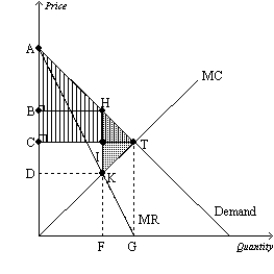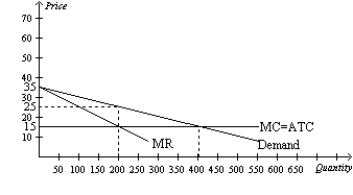A) and a monopolist are price takers.
B) and a monopolist are price makers.
C) is a price taker, whereas a monopolist is a price maker.
D) is a price maker, whereas a monopolist is a price taker.
F) None of the above
Correct Answer

verified
Correct Answer
verified
Multiple Choice
For a monopoly firm,
A) price always equals marginal revenue.
B) price always exceeds average revenue.
C) any price-quantity combination will maximize profits.
D) None of the above is correct.
F) B) and C)
Correct Answer

verified
Correct Answer
verified
Multiple Choice
Figure 15-16  -Refer to Figure 15-16. Which triangle represents the monopoly deadweight loss?
-Refer to Figure 15-16. Which triangle represents the monopoly deadweight loss?
A) the triangle with vertical lines that is bordered by ACT
B) the triangle with vertical lines and light grey shading that is bordered by ABH
C) the triangle with vertical lines and dark grey shading that is bordered by HIT
D) the triangle with dark grey shading that is bordered by HKT
F) B) and C)
Correct Answer

verified
Correct Answer
verified
Multiple Choice
Which of the following statements is not correct?
A) Two examples of early antitrust laws are the Sherman and Clayton Antitrust Acts.
B) Antitrust laws automatically prevent mergers between companies that produce similar products.
C) Antitrust laws give the government power to increase competition.
D) Antitrust laws can reduce social welfare if they prevent mergers that would lower costs through more efficient joint production.
F) C) and D)
Correct Answer

verified
Correct Answer
verified
Multiple Choice
The legislation passed by Congress in 1890 to reduce the market power of large and powerful "trusts" was the
A) Morgan Act.
B) Sherman Act.
C) Clayton Act.
D) 14th Amendment.
F) None of the above
Correct Answer

verified
Correct Answer
verified
Multiple Choice
In reality, perfect price discrimination is
A) used by about 75 percent of all monopolies.
B) used by about 50 percent of all monopolies.
C) seldom used by monopolies because it leads to lower profits.
D) rarely possible.
F) A) and C)
Correct Answer

verified
Correct Answer
verified
Multiple Choice
Amanda inherited the only local cable TV/Internet company in town after her father passed away. The company has a local monopoly on the delivery of high-speed Internet service. The company is completely unregulated by the government and is therefore free to operate as it wishes. Assume that Amanda understands the true power of her new monopoly. Which of the following statements is (are) correct? (i) She will be able to set the price of high-speed Internet service at whatever level she wishes. (ii) The customers will be forced to purchase high-speed Internet service at whatever price she wants to set. (iii) She will be able to achieve any profit level that she desires.
A) (i) only
B) (ii) only
C) (i) and (iii) only
D) (i) , (ii) , and (iii)
F) C) and D)
Correct Answer

verified
Correct Answer
verified
Multiple Choice
Figure 15-18  -Refer to Figure 15-18. If the monopoly firm is not allowed to price discriminate, then consumer surplus amounts to
-Refer to Figure 15-18. If the monopoly firm is not allowed to price discriminate, then consumer surplus amounts to
A) $1,000.
B) $2,000.
C) $3,000.
D) $4,000.
F) A) and D)
Correct Answer

verified
Correct Answer
verified
Multiple Choice
A monopolist faces a
A) horizontal demand curve.
B) vertical demand curve.
C) downward-sloping demand curve.
D) U-shaped demand curve.
F) B) and C)
Correct Answer

verified
Correct Answer
verified
Multiple Choice
In order for antitrust laws to raise social welfare, the government must
A) disallow synergy benefits from accruing to monopolists.
B) disallow any mergers from taking place.
C) be able to determine which mergers are desirable and which are not.
D) always attempt to keep markets in their most competitive form.
F) B) and D)
Correct Answer

verified
Correct Answer
verified
True/False
In a monopoly market, the socially efficient quantity of output is typically higher than the profit-maximizing quantity of output for the monopolist.
B) False
Correct Answer

verified
Correct Answer
verified
Multiple Choice
A profit-maximizing monopolist charges a price of $12. The intersection of the marginal revenue and marginal cost curves occurs where output is 10 units and marginal cost is $6. Average total cost for 10 units of output is $5. What is the monopolist's profit?
A) $60
B) $70
C) $100
D) $120
F) A) and B)
Correct Answer

verified
Correct Answer
verified
Multiple Choice
Encouraging firms to invest in research and development and individuals to engage in creative endeavors such as writing novels is one justification for
A) resource monopolies.
B) natural monopolies.
C) government-created monopolies.
D) breaking up monopolies into smaller firms.
F) B) and D)
Correct Answer

verified
Correct Answer
verified
Multiple Choice
Which of the following is not an example of price discrimination by a firm?
A) children's meals at a restaurant
B) a natural gas company charging customers a higher rate in the winter than in the summer
C) a senior citizens' discount
D) coupons in the Sunday newspaper
F) A) and D)
Correct Answer

verified
Correct Answer
verified
Multiple Choice
Suppose most people regard emeralds, rubies, and sapphires as close substitutes for diamonds. Then DeBeers, a large diamond company, has
A) less incentive to advertise than it would otherwise have.
B) less market power than it would otherwise have.
C) more control over the price of diamonds than it would otherwise have.
D) higher profits than it would otherwise have.
F) A) and D)
Correct Answer

verified
Correct Answer
verified
True/False
The best option to control the behavior of a natural monopoly is to use public ownership of the monopoly.
B) False
Correct Answer

verified
Correct Answer
verified
True/False
A monopolist produces where P = MC = MR.
B) False
Correct Answer

verified
Correct Answer
verified
Multiple Choice
Scenario 15-4 Suppose a monopolist has a demand curve that can be expressed as P=90-Q. The monopolist's marginal revenue curve can be expressed as MR=90-2Q. The monopolist has constant marginal costs and average total costs of $10. -Refer to Scenario 15-4. The profit-maximizing monopolist will charge a price of
A) $50.
B) $40.
C) $20.
D) $10.
F) None of the above
Correct Answer

verified
Correct Answer
verified
Multiple Choice
Drug companies are allowed to be monopolists in the drugs they discover in order to
A) increase the availability of expensive but useful medications.
B) increase the overall welfare of society through better health because drug companies continually produce better medications.
C) encourage research.
D) All of the above are correct.
F) None of the above
Correct Answer

verified
Correct Answer
verified
Multiple Choice
When a firm operates under conditions of monopoly, its price is
A) not constrained.
B) constrained by marginal cost.
C) constrained by demand.
D) constrained only by its social agenda.
F) C) and D)
Correct Answer

verified
Correct Answer
verified
Showing 201 - 220 of 662
Related Exams